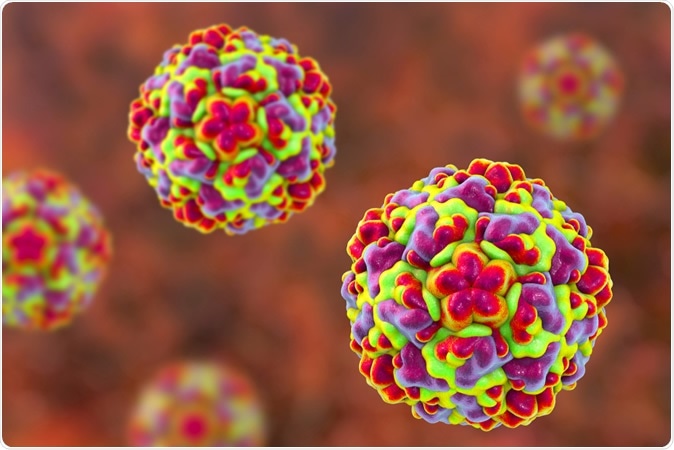The common cold virus (and its more deadly cousins, the viruses that cause polio and acute flaccid myelitis) may just have met its nemesis. In a recent study published in the journal Nature Microbiology on September 16, 2019, scientists reported a potentially successful new approach to stop cold viruses from replicating inside human cells – by blocking the formation of a protein that is vital to this process. This completely inhibited viral replication in mice and human lung cells, and will encourage work on making a drug that can be tested in humans.

Molecular model of rhinovirus, the virus that causes common cold and rhinitis, 3D illustration - Illustration Credit: Kateryna Kon / Shutterstock
Common colds seldom cause more than inconvenience, but this can be a severe impediment to daily activities. In asthma-prone individuals, on the other hand, a cold can trigger a flare-up. Certain other enteroviruses can also cause paralysis by spreading along neural pathways to the brain.
Most colds are caused by a type of virus called rhinoviruses, belonging to the enterovirus family that also contains polio viruses. There are approximately 160 types of rhinovirus. A common cold vaccine has been impossible so far because of the way they change their genes around, either to induce antibiotic resistance or mask the virus from patrolling immune cells. This has led to a change of tactics – instead of targeting the virus itself, the new approach is to tackle the host cell which harbors the virus, rendering it unwelcoming.
This strategy exploits the weakness of all viruses – they cannot replicate on their own because of the bareness of their genetic cupboards. Instead, when they want to replicate, they basically hijack the host cell’s genome, taking over the cell machinery to churn out new copies of themselves instead of serving the host cell functions. This basic hole in viral anatomy is the fundamental reason why scientists are still not sure if these are living particles or not.
How it was done
In the current experiment, the attempts to protect the host cell started with gene-editing, using a special tool to switch off genes that transcribe instructions to make new cells. They then exposed the modified cells to a variety of enteroviruses, including the rhinoviruses and paralyzing viruses similar to the polio virus. They found, to their satisfaction, that inactivating one gene which codes for an enzyme called actin histidine methyltransferase completely abolished viral replication inside that cell by blocking the production of a copy of the RNA genome of the virus.
In the next step, they created knockout mice which lack the gene for this protein. When these mice were exposed to viruses, they showed a hundred percent protection. Historically, these mice should always have died instead!
Not only did they survive virus exposure following the introduction of this mutation, but they also showed a very large drop in viral replication and extremely strong protection against viral infection. The enzyme which is not produced in these cells is essential for the formation of a strong cytoskeleton, the complicated supporting fibers that hold various parts of the cell in place.
How it works
The SETD3 domain of the enzyme actin histidine methyltransferase is essential for the enteroviral RNA to replicate itself using the host cell machinery. This domain has been found to interact with a viral protein, an enzyme called 2A protease, in a specific manner within a host of enteroviruses. The amino acid residues that participate in this interaction were also identified in the current study.
A mutation which allows the 2A protease to split proteins but prevents its interaction with SETD3 badly affects RNA replication. Thus the viral 2A protease appears to play a role in viral replication far beyond cleaving proteins. The absence of an intact SETD3 domain with which the protease can interact is therefore mandatory for enterovirus replication.
The next step
Since genetically modifying humans is not a feasible approach against the common cold, the scientists are now exploring chemical avenues to identify a drug that can prevent the synthesis of this protein for a short while, thus protecting against the cold. Researcher Jan Carette says, “We have identified a fantastic target that all enteroviruses and rhinoviruses require and depend on. Take that away and the virus really has no chance. The second step is to have a chemical that mimics this genetic deletion.”
Further research will also look into how this protein affects viral replication by targeting the exact site of action.
In a comment, virologist Jonathan Ball said, “Treatments that target these host proteins can potentially overcome virus mutation - one of the major barriers to developing effective broadly active antivirals. But of course, viruses are very adaptable and it is conceivable that even a host-targeting treatment might not keep them at bay for long.”
Journal reference:
Enterovirus pathogenesis requires the host methyltransferase SETD3. Jonathan Diep, Yaw Shin Ooi, Alex W. Wilkinson, Christine E. Peters, Eileen Foy, Jeffrey R. Johnson, James Zengel, Siyuan Ding, Kuo-Feng Weng, Orly Laufman, Gwendolyn Jang, Jiewei Xu, Tracy Young, Erik Verschueren, Kristi J. Kobluk, Joshua E. Elias, Peter Sarnow, Harry B. Greenberg, Ruth Hüttenhain, Claude M. Nagamine, Raul Andino, Nevan J. Krogan, Or Gozani & Jan E. Carette. Nature Microbiology (2019). DOI: 10.1038/s41564-019-0551-1. https://www.nature.com/articles/s41564-019-0551-1#Abs1